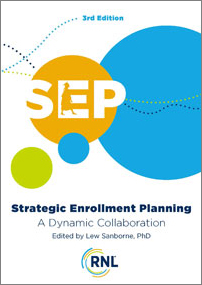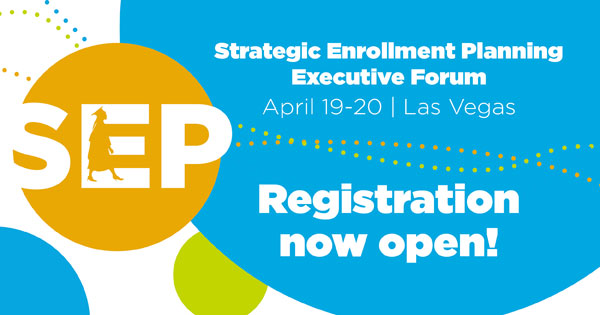enrollment
Strategic Enrollment Planning: A Q&A for Enrollment Managers

For over a decade now I have led strategic enrollment planning work at RNL. It’s my pleasure and feeds my passion to work with colleges and universities of every size, type, and mission to create strategic enrollment plans that help them respond to a turbulent environment and to align with ever-changing academic demands, employment needs, and student diversity.
In this post, I share some common questions I hear from campus leaders as a way to encourage you to attend RNL’s Strategic Enrollment Planning (SEP) Executive Forum, April 19-20 in Las Vegas. Consider bringing a team to get started on the process for your college or university.
What are the most pressing issues enrollment leaders have, and how can strategic enrollment planning address them? Here are some common questions I hear from campus leaders.
Between more and more of the population questioning the value of higher education and increased competition, how can I continue to attract students to study at my institution and convince them of the value of earning a degree or other credential?
As we increasingly function as if we are in a post-pandemic environment, most of us are still trying to figure out what the new normal is going to look like. If we are not imagining how prospective and current student mindsets have changed, have been influenced by multiple semester of enforced online learning and isolation, we cannot build strategies to meet them where they are and will be. Spring 2023 brought the first year over year enrollment increase in a decade, but was it a blip or the first step on an enrollment recovery? Resilient institutions will be those whose strategic enrollment plans have the flexibility to respond to movement in either direction this fall. But is imperative that we extend our vision beyond just the next year. Our current SEP partners are balancing their efforts to bring in the next entering class while building strategies to position themselves three to five years out.
What are the building blocks of a strategic enrollment plan?

President Eisenhower once said, “Plans are nothing; planning is everything.” The foundation of a good strategic enrollment plan is a good strategic enrollment planning process.
The key is to bring the right people together, provide them with access to institutional and external data, foster collaboration across the institution, embrace transparency, and roll up your sleeves and get to work. Know at the outset that the goal is not to do everything, but to use data to identify the strategies that have the greatest potential to improve institutional performance and that will mobilize the campus community to action. It sounds simple, but it requires strong leadership. We simply don’t have the bandwidth to do everything, so a systematic, data-informed planning process with clear criteria for prioritization is an absolute must.
Pictured: The third edition of our book, Strategic Enrollment Planning: A Dynamic Collaboration, will be out in spring 2023 and provided to each attendee at the 2023 SEP Forum. This books is the most extensive on the topic and elaborates on the topics I discuss here as well as many other key areas of SEP.
What distinguishes strategic enrollment planning from recruitment and retention planning?
Typically our recruitment plan is an annual plan, a roadmap for what we are going to do to bring in the next class. Likewise our retention plans often focus on improvements to our service and support portfolio to bring incremental gains to student success with the next cohort. Strategic enrollment planning starts with institutional mission and then links academic program planning and fiscal planning with recruitment and retention planning.
Our marketing and recruitment efforts are designed to bring students to our institutions to study in our academic programs. Our retention efforts are designed to foster student success so that students will remain enrolled in our programs and then complete them. The entire financial enterprise, from capital campaigns to financial aid disbursement, are designed to help students enroll, to provide quality programs, and to pay the bills. If enrollment planning is just about getting students and keeping them, then it is not likely strategic nor sufficiently holistic.
While strategic enrollment planning will not magically remove organizational silos, by design it will lessen their effects on organizational collaboration because individuals from across the institution will come together to identify challenges and opportunities, as well as develop plans that will strengthen the enrollment and the fiscal foundation of the institution.
How do we develop an effective strategic enrollment plan that includes input and collaboration from all areas of the college?
One of the first steps of any strategic enrollment planning process is the construction of an organizational structure. We’ll cover this in detail during our SEP Forum, with particular attention to variation by institutional types and a focus on the uniqueness of each campus attending, but here are a few pointers. The SEP leadership group should include key campus experts—from enrollment, academic affairs, and finance—but should not necessarily be representative of all divisions or it will get too large (and so less effective). A structure with a coordinating group supported by working groups with particular focus areas—i.e. marketing and recruitment, finance and financial aid, academic programs, student success—will expand the number of participants and allow for representation when the organizational structure moves to the second, working group level.
What trends should we be paying attention to as we begin planning?
The fast approaching decline in the direct from high school population is old news, but still essential to plan for. Most schools need explicit strategies to attract and serve adult students with the flexibility they now expect. We need to be prepared for students to expect more delivery modality options, including online, whether they are adult, traditional, on-site, or online. We also need to be diversifying outreach and marketing efforts across multiple channels, being both proactive and response in highly customized and personalized ways. We are also seeing shifts in academic program demand; depending on your institutional type, we should be planning to deliver credentials that can be completed in a shorter time-frame than the traditional 120 credit bachelor’s, or even the one-year master’s degree.
How do we measure the success of a strategic enrollment plan?
Another early step in the process is determination of Key Performance Indicators (KPIs). Ultimately the strategic enrollment plan is successful if the metrics you identified as important at the outset move in the desired direction through the implementation period of the plan.
At the same time, a good planning process should have organizational and cultural benefits beyond just moving the metrics. An inclusive, transparent planning process should engage the campus community and raise awareness of how enrollment influences institutional health and success. It may also break down silos, provide a common campus vocabulary, and change the ways institutions use data in decision making. Campus culture and climate changes may be harder to measure but should be an important aim of the SEP process.
How do we effectively use data in making enrollment decisions?
At RNL, we prefer data-informed decisions to data-driven decisions.
Colleges and universities are complex organizations, and focusing only on the data can lead to overlooking important cultural and human elements that should be considered in the decision-making process. That said, we are committed to using data to the best of our abilities to inform decisions. How to do that?
First, you need to have data you can trust.
- What does your environmental scan tell you about what’s happening in the demographic and educational market around you?
- What do your internal data tell you about your institution’s performance?
- How does your performance compare to local, regional, or national benchmarks?
When making enrollment strategy decisions, the key is to understand the data first, to look for its messages to help inform your strategy considerations. For example, if you are geographically situated in an area that is seeing growth in a population you have not previously served, then the data would likely suggest a market development opportunity.
If your retention data show that a particular population is under-performing compared to the norm, you will have identified a population that is at risk. You will need to look more deeply at your data to strive to understand the causes of that performance gap before you jump to strategy development.
Similarly, you might discover that a program development strategy will be fairly costly to implement, but the market demand research shows weak enrollment potential. Don’t think of the planning work as wasted effort if you don’t launch the program: to the contrary, your work to collect data and build projections may save your institution from investing in a program that will not cover the costs to deliver.
How can I insure my plan is truly strategic?
In every planning process there is a risk of excessive activity syndrome,of trying to do too many things simultaneously. There is also the risk of playing it safe, of favoring low-risk, low-reward initiatives because you think you can do them with the people and tools you already have.
RNL’s strategic enrollment planning process, by design, leverages the data-informed approach I described above to shift the focus from the tails of the normal distribution to the student populations under the larger part of the curve.
- How many students do we have to recruit or retain for an initiative to be considered strategic?
- How much net revenue do we need to generate?
Obviously the answers to those questions will be different for each institution, but exploring those questions during the planning process is essential to identifying truly strategic initiatives.
What can I expect if I attend the RNL SEP forum?
The answers above only begin to address these frequently asked questions. During the forum, we’ll dig deeper into how to make a strategic enrollment planning process effective for your college or university.
- Our RNL experts and our campus experts will guide you through the process
- You’ll receive resources that provide a template for working the process on your own campus, and an early release of the third edition of RNL’s comprehensive book: Strategic Enrollment Planning: A Dynamic Collaboration.
- The forum is a great opportunity for teams to attend, because you can use it as a launch pad for developing your own SEP process.
Past participants tell us that after the forum they are energized, organized, and prepared to make positive enrollment change happen on their campuses. Take a look at the agenda and join us in Las Vegas on April 19-20!

